#palacio de versailles
Text

Royal Chapel Versailles Palace
#royal chapel#chapelle royale#capilla real#palais de versailles#versailles palace#palacio de versailles#france#francia#europe#europa
176 notes
·
View notes
Photo

(vía El Gran Canal de Versalles)
#andré le nôtre#versalles#palacio de versalles#versailles#architecture#arquitectura#parques y jardines#estanques#luis xiv#archivo del blog#blog archives#Gardens
2 notes
·
View notes
Text



#marinette dupain cheng#miraculous fanart#miraculous ladybug#palacio de versalles#the rose of versailles#ai art#cartoon#anime#ai generated#ai girl#ai artwork#ai image#ai sexy#tumblr milestone
4 notes
·
View notes
Text
Versailles
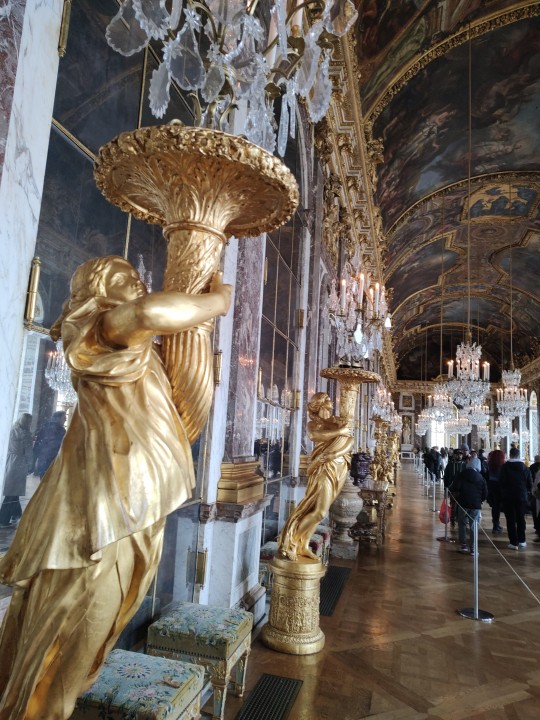
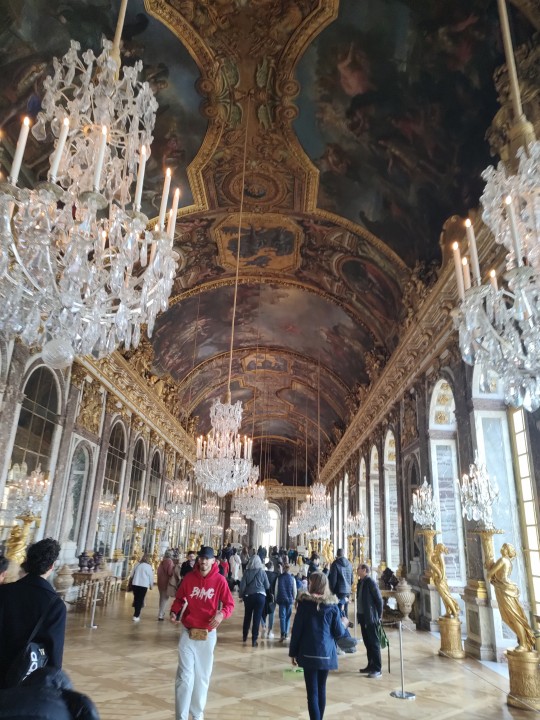



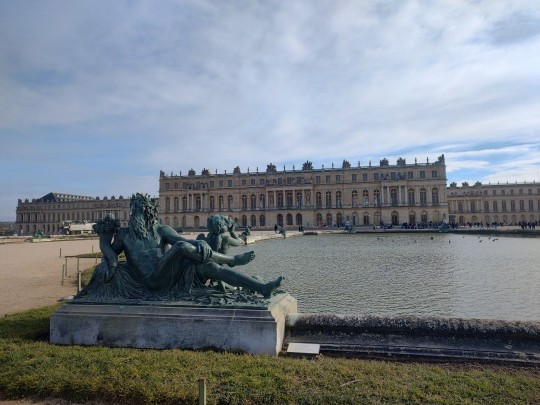
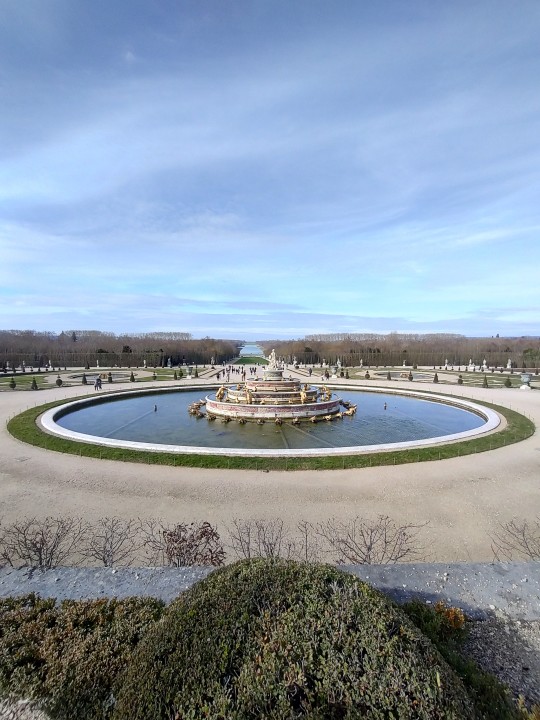
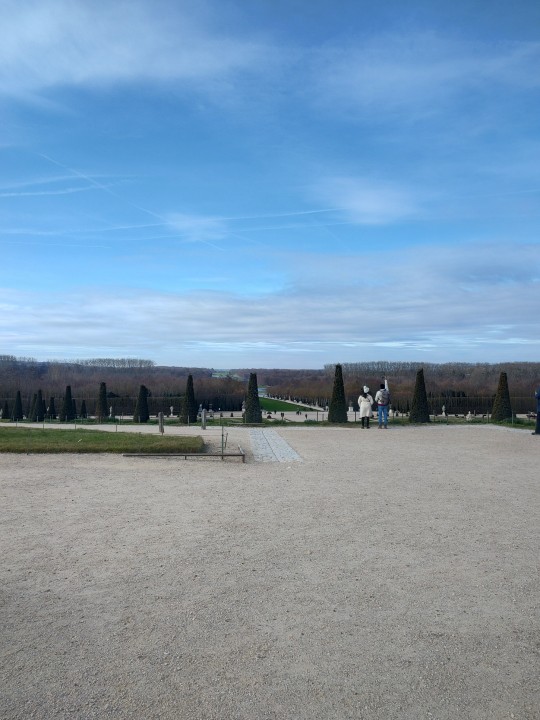
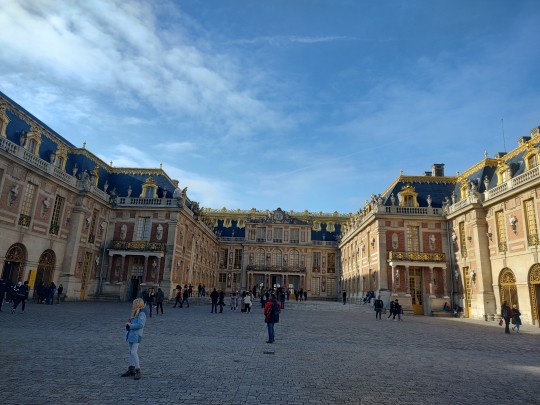

#europa#france#versailles#palais#roi de france#roi soleil#louis xiv#monumenthistorique#chateau#architecture#art deco#jardin#fontaine#galerie de glaces#grand canal#europe#francia#versalles#palacio#castillo#arquitectura#monumento historico#fuentes#canal
7 notes
·
View notes
Text
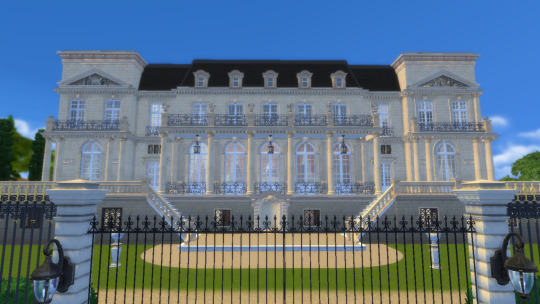

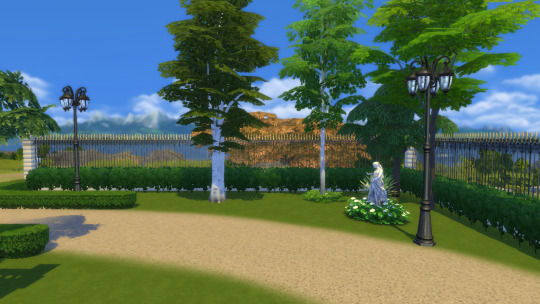
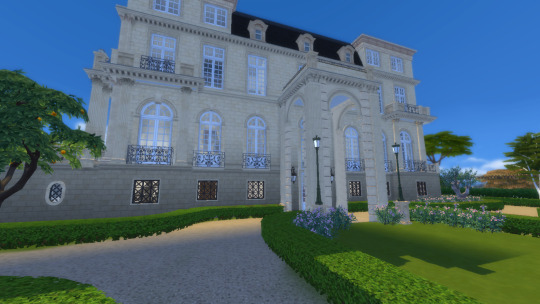



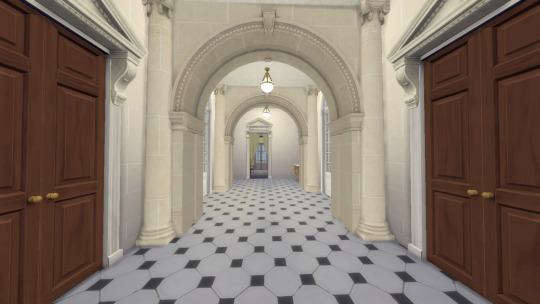

Sans Souci Palace
Hi gouys! This is the Sans Souci Palace, located in Buenos Aires, Argentina.
This house is set to be in a 64x64 Lot. You will need all cc from The Jim, Felixandre, SYB, Marble Mortal, GSsims, etc. It is the usual content I use for my houses.
I made the third floor but it is not completed. In fact, the residence does not have this 3rd floor, but the roof looked weird w/o it.
Some history:
The Sans Souci Palace, located in Victoria, is undoubtedly one of the architectural landmarks not only of San Fernando but also of the northern region. This December marks 100 years since its official inauguration. Its history is intertwined with the history of the neighborhood, and its construction marked a turning point in the urban vision of the district's waterfront.
To briefly recount its history, we can go back to 1911 when the Alvear siblings, Carlos María, Josefina, and Elisa, married to Mercedes Elortondo, Matías Errázuriz, and Ernesto Bosch, respectively, traveled to Paris, France, in search of an architect to design their residences on the embankments of the area. The three couples chose the trendy architect of the time: René Sergent, considered the best in neoclassical and Versailles-style architecture.
The French architect also built the Bosch Palace in Buenos Aires, which serves as the official residence of the United States ambassador, and the Errázuriz Palace, now the Museum of Decorative Arts. The Sans Souci palace, owned by Carlos María de Alvear and his family, was the last of the three projects to be designed.
In 1914, the builders Eduardo Lanús and Pablo Hary laid the foundation stone of the Palace on the land inherited by Alvear's wife in Victoria, San Fernando. In December 1918, it was officially inaugurated.
Its four facades are made of imitation stone. The stairs are made of Paris marble, while the rest of the details and finishes, although they appear to be genuine, are imitations. The imitation marble was created by Swiss craftsmen from the Italian canton who were specialists in this technique. All the carpentry in the Sans Souci Palace was made of Slavonian oak. The doors were painted to imitate the wood grain, giving them identical marks.
The gardens, which initially covered 9 hectares, were designed by the French landscape architect Carlos Thays. During the construction of the Palace, Alvear tried to buy the neighboring property belonging to the Lanusse family with the intention of demolishing it and expanding his garden. However, the Lanusse family never agreed, so a huge wall was built. Thays not only organized the garden but also planted a group of trees to hide the large wall, making it appear as though the house extended further.
(From https://www.quepasaweb.com.ar/100-anos-palacio-sans-souci-san-fernando/)
DOWNLOAD HERE: patreon.com/user?u=75230453
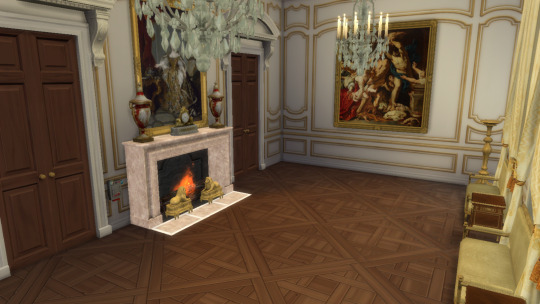

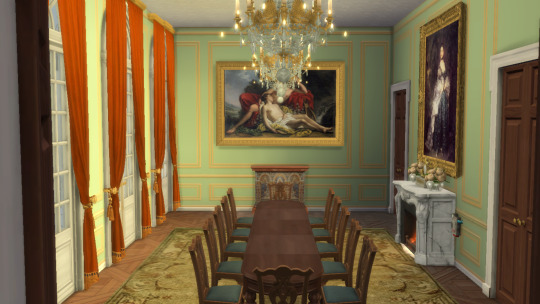
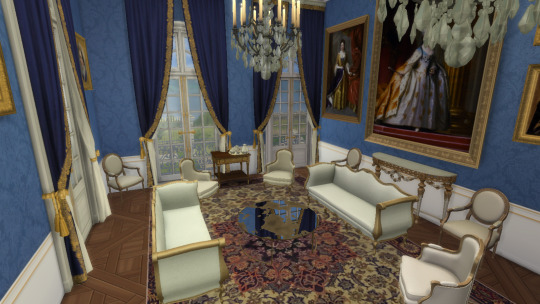
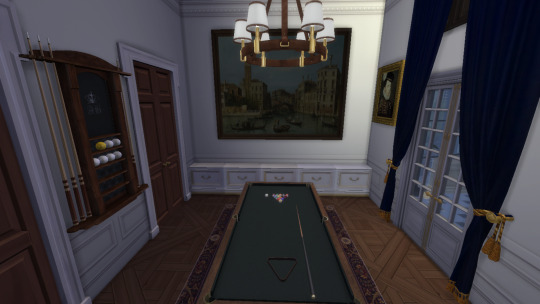
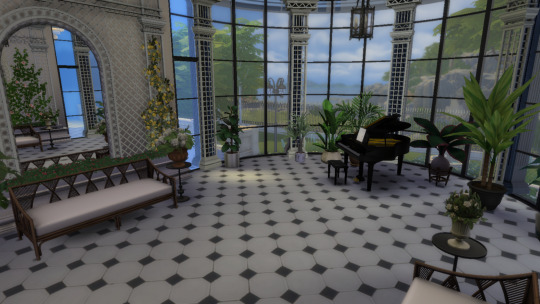

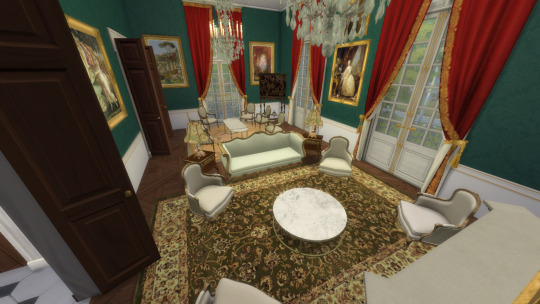
#sims 4 architecture#sims 4 build#sims4palace#sims4#sims 4 screenshots#sims4play#sims 4 historical#sims4building#sims 4 royalty#sims4frencharchitecture#ts4#ts4 build#ts4 screenshots#the sims 4#sims 4
41 notes
·
View notes
Text



⚜️ Preciosos detalles de la cama de Madame du Barry en el Palacio de Versailles, Francia ⚜️
©Antoine
༻🌹༺
#madame du barry#versailles#chateau#palace#passementerie#rococo#rococó#rococo art#18th century#siglo xviii
99 notes
·
View notes
Photo

🏛️The Château de Versailles, a place to always go back. - 📌One of my favorite things of this castle: passage spaces are beautiful and poetic too. This photo was taken on my first post-pandemic trip, and cannot wait to return. We are in a “modern” vestibule created during its conversion to museum in Louis Philippe reign. Even so, it was one of the first halls in the castle built in 1679 to communicate the marble court and the gardens. During Louis XV and Queen Marie Antoinette’s time, this space was reused for private apartments and it was located a library. 🎵 Tom Jones, Overture - François-André Danican Philidor, 1765 @chateauversailles - #palace #admagazine #architecture #neoclassic #barroco #palacio #museums #baroque #versailles #castle (en Château de Versailles) https://www.instagram.com/p/CpTFqUzgBne/?igshid=NGJjMDIxMWI=
34 notes
·
View notes
Text


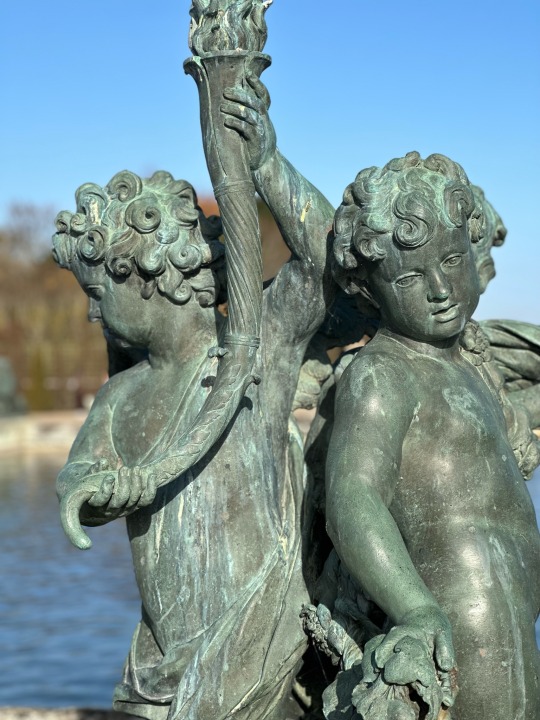

Palacio de Versailles
16 notes
·
View notes
Text

source: bishopsbox
Léon Bonnat, Portrait of Victor Hugo, c. 1877-1879, Museum of French History,Palace of Versailles.
Léon Bonnat, Retrato de Victor Hugo, c. 1877-1879, Museo de Historia Francesa, Palacio de Versalles.
10 notes
·
View notes
Text
Events 4.11 (before 1970)
491 – Flavius Anastasius becomes Byzantine emperor, with the name of Anastasius I.
1241 – Batu Khan defeats Béla IV of Hungary at the Battle of Mohi.
1512 – War of the League of Cambrai: Franco-Ferrarese forces led by Gaston de Foix and Alfonso I d'Este win the Battle of Ravenna against the Papal-Spanish forces.
1544 – Italian War of 1542–46: A French army defeats Habsburg forces at the Battle of Ceresole, but fails to exploit its victory.
1689 – William III and Mary II are crowned as joint sovereigns of Great Britain on the same day that the Scottish Parliament concurs with the English decision of 12 February.
1713 – France and Great Britain sign the Treaty of Utrecht, bringing an end to the War of the Spanish Succession (Queen Anne's War). Britain accepts Philip V as King of Spain, while Philip renounces any claim to the French throne.
1727 – Premiere of Johann Sebastian Bach's St Matthew Passion BWV 244b at St. Thomas Church in Leipzig, Electorate of Saxony (now Germany).
1809 – Battle of the Basque Roads: Admiral Lord Gambier fails to support Captain Lord Cochrane, leading to an incomplete British victory over the French fleet.
1814 – The Treaty of Fontainebleau ends the War of the Sixth Coalition against Napoleon Bonaparte, and forces him to abdicate unconditionally for the first time.
1856 – Second Battle of Rivas: Juan Santamaría burns down the hostel where William Walker's filibusters are holed up.
1868 – Former shōgun Tokugawa Yoshinobu surrenders Edo Castle to Imperial forces, marking the end of the Tokugawa shogunate.
1876 – The Benevolent and Protective Order of Elks is organized.
1881 – Spelman College is founded in Atlanta, Georgia as the Atlanta Baptist Female Seminary, an institute of higher education for African-American women.
1908 – SMS Blücher, the last armored cruiser to be built by the Imperial German Navy, is launched.
1909 – The city of Tel Aviv is founded.
1921 – Emir Abdullah establishes the first centralised government in the newly created British protectorate of Transjordan.
1935 – Stresa Front: opening of the conference between the British Prime Minister Ramsay MacDonald, the Italian Prime Minister Benito Mussolini and the French Minister for Foreign Affairs Pierre Laval to condemn the German violations of the Treaty of Versailles.
1945 – World War II: American forces liberate the Buchenwald concentration camp.
1951 – Korean War: President Truman relieves Douglas MacArthur of the command of American forces in Korea and Japan.
1951 – The Stone of Scone, the stone upon which Scottish monarchs were traditionally crowned, is found on the site of the altar of Arbroath Abbey. It had been taken by Scottish nationalist students from its place in Westminster Abbey.
1952 – Bolivian National Revolution: Rebels take over Palacio Quemado.
1952 – Pan Am Flight 526A ditches near San Juan-Isla Grande Airport in San Juan, Puerto Rico, after experiencing an engine failure, killing 52 people.
1955 – The Air India Kashmir Princess is bombed and crashes in a failed assassination attempt on Zhou Enlai by the Kuomintang.
1957 – United Kingdom agrees to Singaporean self-rule.
1961 – The trial of Adolf Eichmann begins in Jerusalem.
1963 – Pope John XXIII issues Pacem in terris, the first encyclical addressed to all Christians instead of only Catholics, and which described the conditions for world peace in human terms.
1964 – Brazilian Marshal Humberto de Alencar Castelo Branco is elected president by the National Congress.
1965 – The Palm Sunday tornado outbreak of 1965: Fifty-five tornadoes hit in six Midwestern states of the United States, killing 266 people.
1968 – US President Lyndon B. Johnson signs the Civil Rights Act of 1968, prohibiting discrimination in the sale, rental, and financing of housing.
1968 – A failed assassination attempt on Rudi Dutschke, leader of the German student movement, leaves Dutschke suffering from brain damage.
0 notes
Text

Jardin - Palais de Versailles
#jardin#garden#sculpture#escultura#palais de versailles#versailles palace#palacio de versailles#versailles#france#francia#europe#europa
64 notes
·
View notes
Photo

(vía Perseo y Andrómeda, Jardines de Versalles / Perseus and Andromeda, Versailles' Gardens)
#escultura#sculpture#Barroco#baroque#Luis XIV#Palacio de Versalles#versailles#jardines#gardens#Pierre Puget#arte#art#fotografía#photography
0 notes
Text
Versalles (2015)
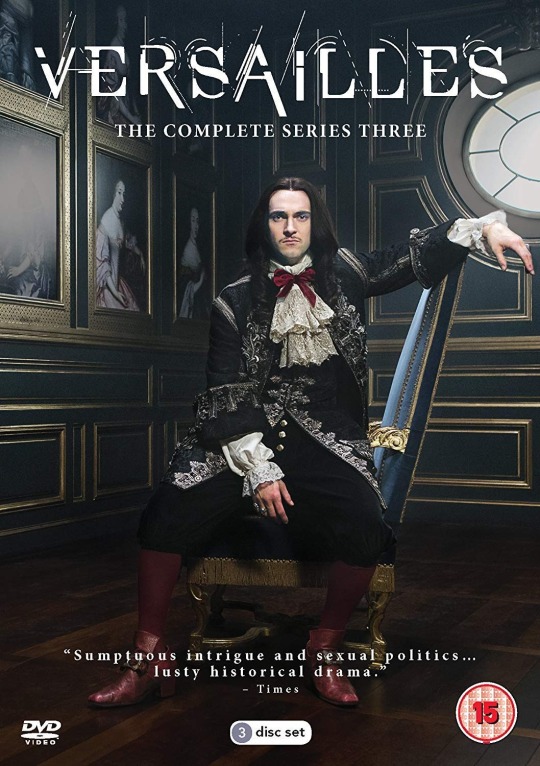
La serie "Versailles" del 2015 es un drama histórico que se centra en la vida del rey Luis XIV de Francia y la construcción del Palacio de Versalles. La trama sigue al joven rey mientras lucha por mantener el control de su reino y enfrenta desafíos políticos, intrigas en la corte y conflictos personales. A lo largo de la serie, se exploran las complejas relaciones entre los personajes y se muestra la arquitectura que refleja la opulencia y la grandeza del palacio real, mostrando en detalle los majestuosos salones, jardines elaborados y la arquitectura barroca característica de la época. Los escenarios y decorados recrean fielmente los interiores y exteriores del palacio, brindando una visión espectacular de la arquitectura de Versalles en el siglo XVII. Los detalles arquitectónicos, los muebles suntuosos y la ornamentación extravagante son elementos destacados que contribuyen a la ambientación visual de la serie.

La trama aborda la intriga política, las rivalidades entre la nobleza y las complejas relaciones personales en la corte del rey. Además la serie es conocida por su lujoso diseño de producción y su enfoque en los personajes históricos.
En general, "Versailles" ha sido popular entre los amantes de los dramas históricos y ha generado interés en la vida y el reinado de Luis XIV. En mi opinión, si estás interesado en la historia de Francia o en los dramas de época, "Versailles" podría ser una serie que te ayude a comprender toda la historia que conlleva.
@lonuevodenuevo
Daniela González | Historia II
Profesora Arq. Rebeca Tineo
0 notes
Text
Ensayo-Versailles
Versailles es una serie de televisión franco-canadiense que relata la construcción del Palacio de Versalles durante el reinado de Luis XIV. Extrenada en el 2015 en el Canal+ (Se pueder ver en Netflix)
En la serie "Versailles" (2015), se nos presenta una fascinante adaptación de la arquitectura a su contexto, específicamente en relación con el poder de la corona francesa. La trama gira en torno a la época en la que Luis XIV ostenta el poder, explorando la autoridad y las responsabilidades inherentes a la realeza.
La trama destaca la disconformidad de la corte real respecto a vivir en Versalles. Luis XIV, con la visión de transformar el pabellón de caza de su padre en una obra maestra arquitectónica, aspira a cautivar y conquistar los corazones de aquellos que lo contemplen. Este deseo del rey por crear un ícono que eleve la gloria de la nación es evidente a lo largo de la serie.

El proyecto que se plantea se revela como sumamente ambicioso, repleto de innovaciones y desafíos, especialmente en el ámbito del paisajismo. El palacio es concebido como un símbolo, con un imponente salón de luz diseñado para seguir el amanecer e iluminar todos los rincones del mundo, destacando así la grandeza de Francia.
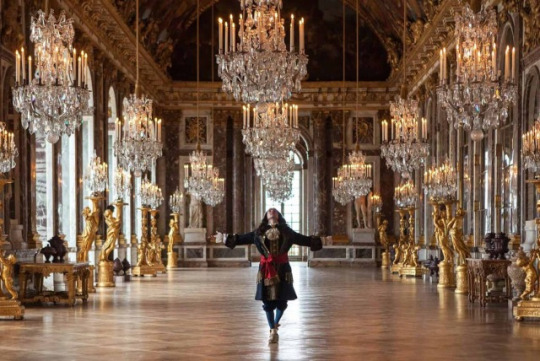
"Quieres un paraíso, constrúyelo":
Esta premisa encarna la filosofía del Rey Luis XIV, quien comprende que para materializar sus aspiraciones se requiere un cambio. Reconoce que el cambio no es perjudicial, sino esencial para el progreso y la evolución. El proyecto del palacio, además de ser monumental, refleja un nuevo clasicismo francés de la época, marcando un giro hacia la construcción de "una nueva Francia". También evidencia un interés en el intelecto femenino, desafiando las convenciones de la época que tachaban de brujas a las mujeres que buscaban conocimiento.
Este cambio provoca una lucha de poder entre el Rey y aquellos temerosos del cambio, subrayando la importancia de las alianzas con otras naciones para enfrentar dicha guerra, buscando beneficios mutuos. Aunque Francia resalta su superioridad y liderazgo, también se vislumbra la complejidad de las relaciones políticas.
En la serie, se plasma la pasión de Luis XIV por el progreso, mientras busca llevar la gloria a su reino mediante sus aspiraciones.
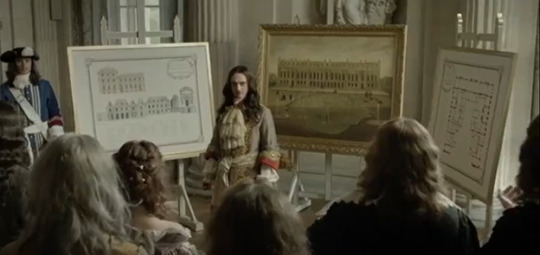
0 notes
Text
Sintra et ses châteaux…
Sintra, située à quelques kilomètres de Lisbonne, peut s'enorgueillir d'avoir de nombreux châteaux à proposer à la visite.

Mercredi 1er novembre, nous choisissons d'accéder au premier château en randonnant, ce qui représente tout de même une ascension continue d'une heure et demie...avec une bonne dénivelée. Le chemin d'accès présente une nature magnifique.
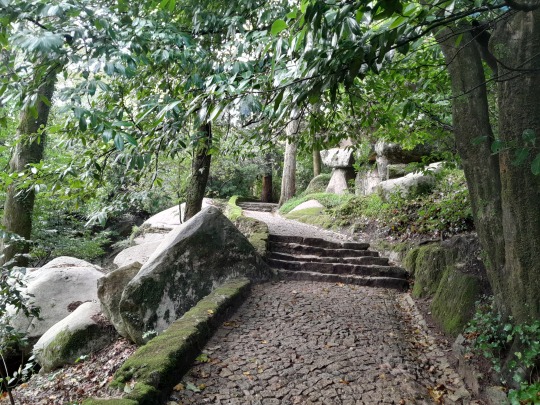
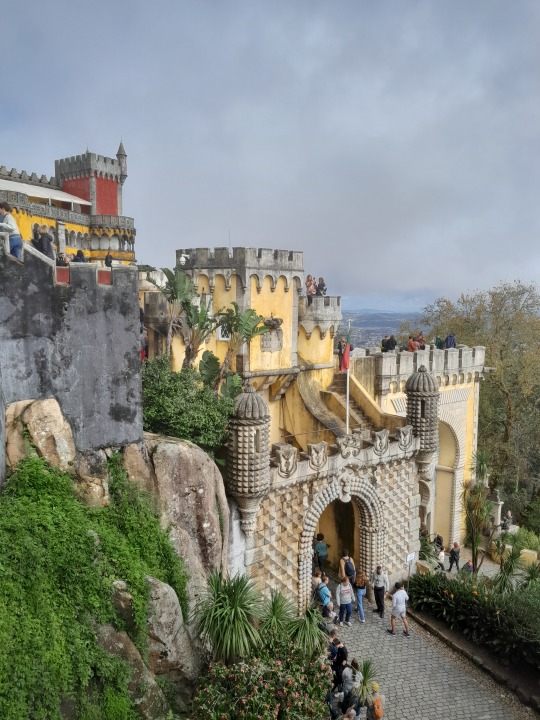
Voici le Palacio Nacional da Pena, nous sommes peu nombreux à y accéder à pied, plutôt qu'en minibus ou même en Tuk tuk, mais nous nous retrouvons par centaines à l'arrivée!

C'est en 1854, qu'un baron, plus géographe qu'architecte, à l'imagination débordante, conçoit un édifice exubérant, éclectique mêlant toutes sortes de styles.

Ce château est au sommet d'une colline et la vue à 360° est époustouflante. Dominant et coloré, on le repère aussi de très loin.
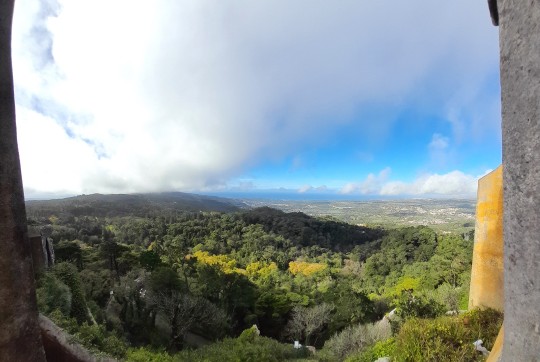
En redescendant, nous rejoignons le Castello dos Mouros, dont l'originalité est son chemin de ronde crénelé qui épouse les formes abruptes de la colline .
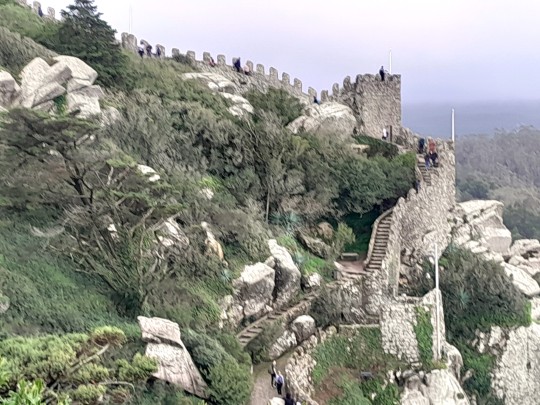
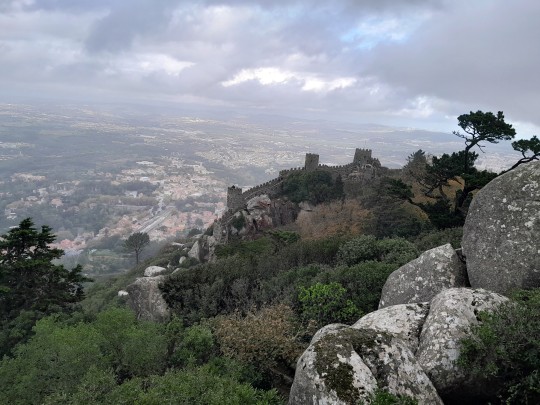

Jeudi 2 novembre : nous faisons le choix de visiter le Palacio e Quinta da Regalera ; ici encore la demeure est née, au tout début du XXème siècle, de l'imagination exaltée d'un "très riche" ayant fait fortune au Brésil grâce au commerce du café et des pierres précieuses. Le sous sol du parc est parcouru de galeries que les visiteurs peuvent emprunter librement.
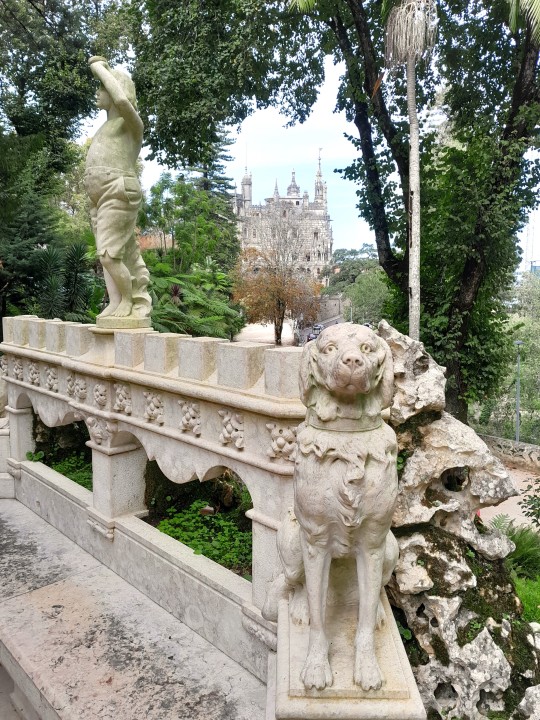
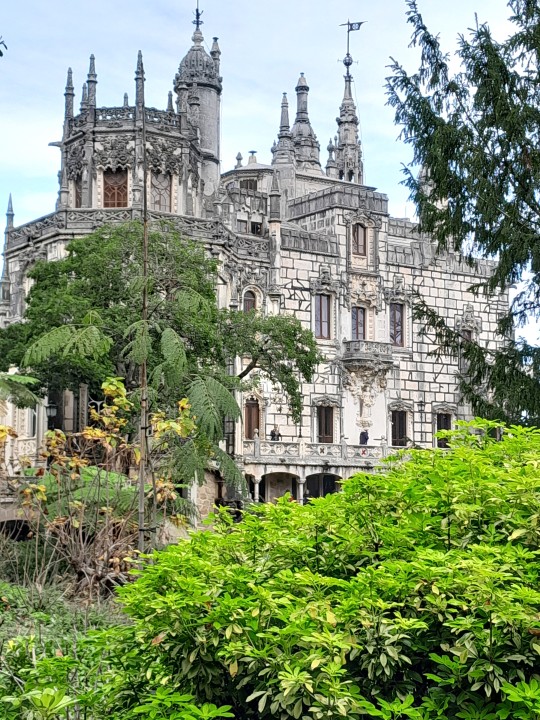
Le plus extraordinaire est "le puits initiatique", que l'on descend par un escalier en colimaçon de 27 mètres de hauteur, à la manière d'une tour inversée.

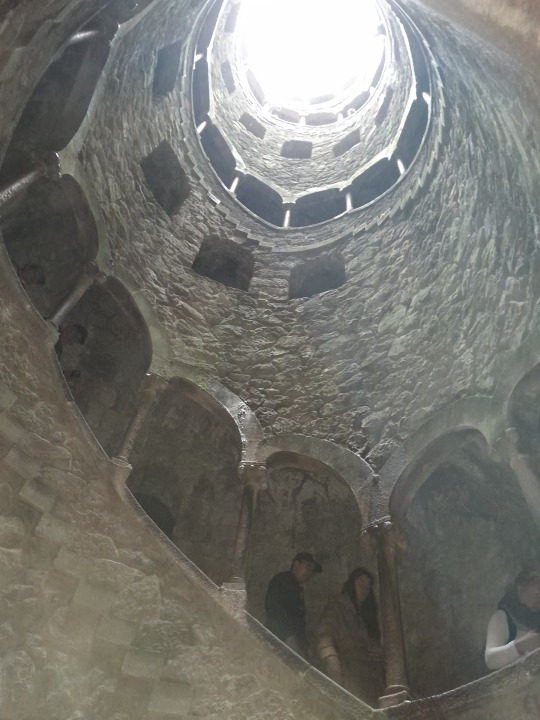
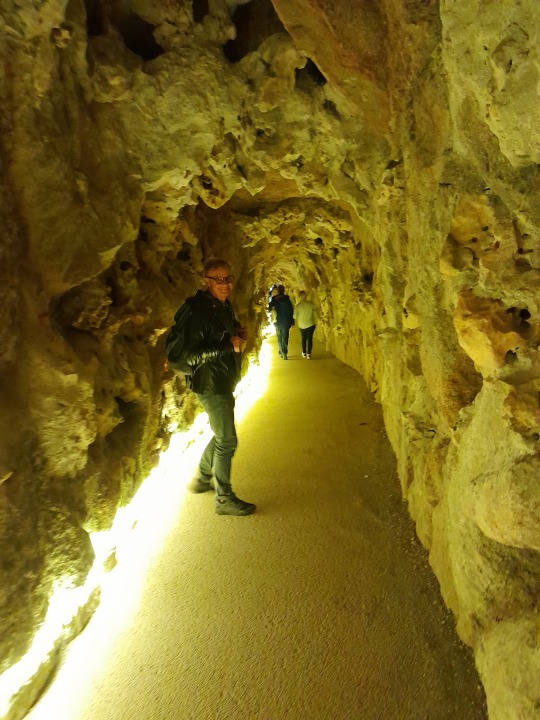


Le parc de cette demeure comporte plusieurs fontaines et bassins.
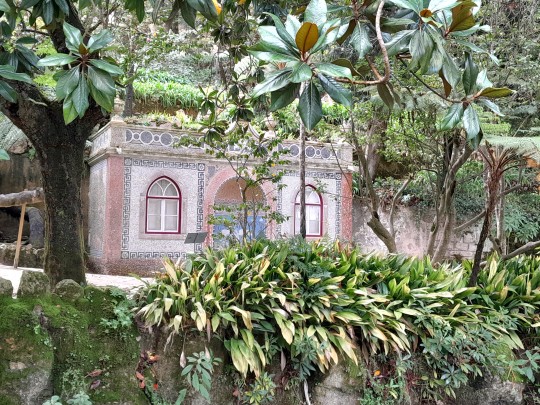
L'après-midi, nous partons en visite à Queluz, et son Palacio Real. La météo n'est pas très bonne… Ce château a été construit à partir de 1747 et il a servi de résidence à un certain nombre de rois et reines du Portugal. Il s'agit d'un petit "Versailles", mais qui n'a pas été aussi bien entretenu.

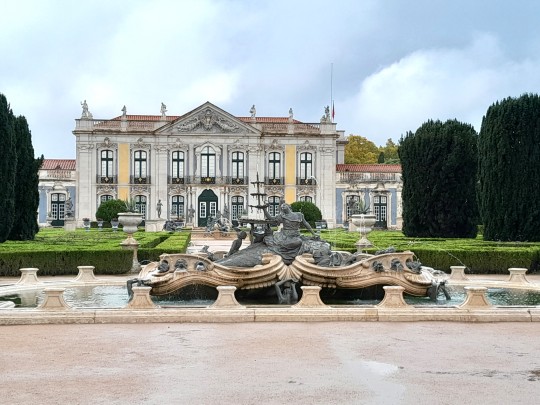
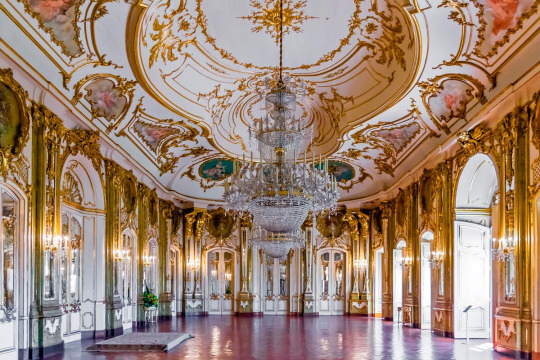
Cette salle de réception est vraiment incroyable.

C'est ici que se terminent nos aventures portugaises !! Adeus.
Nous mettons le cap sur une contrée plus ensoleillée...à suivre !
0 notes
Text
• Una de las óperas más hermosas del mundo es sin duda la ópera real de Versalles. Es el teatro y ópera principal del Palacio de Versalles, en Francia. Diseñado por Ange-Jacques Gabriel y con una decoración de interiores de Augustin Pajou, la ópera fue construida totalmente de madera y pintada para parecer mármol con una técnica conocida como falso mármol.

• Panorámica dónde se encuentra en Francia 👆 (Europa), el Palacio de Versailles.
• El edificio está ubicado en el extremo norte del ala de los nobles. El acceso del público general al teatro es a través del vestíbulo de dos pisos. Algunas partes de la ópera, tales como los aposentos del rey, representan una de las primeras expresiones de lo que se convertiría en el «estilo Luis XVI»
• El Persée de Jean-Baptiste Lully —escrita en 1682, el año en que Luis XIV se mudó al palacio— inauguró la ópera el 16 de mayo de 1770 en celebración del matrimonio del delfín —el futuro Luis XVI— con María Antonieta.
• La ópera real puede servir tanto como un teatro para ópera, piezas teatrales u orquesta (con una capacidad para 712 personas), así como una salle des festins, cuando el piso del nivel de la orquesta del auditorio puede ser alzado al nivel del escenario. En estas ocasiones, la ópera tiene una capacidad para 1.200 personas.
🎷🎼🎻𝅘𝅥𝅰𝅘𝅥𝅮🎺♫
Vídeo por Antoine.
Música del vídeo, Max Richter - Las nuevas cuatro estaciones - Vivaldi recompuesto: primavera 1.
#chateaudeversailles#versailles#royal palace#palace#royal style#ópera#architecture#heritage#art history#luxury#french aristocracy#18th century#elegancia#elegance
58 notes
·
View notes